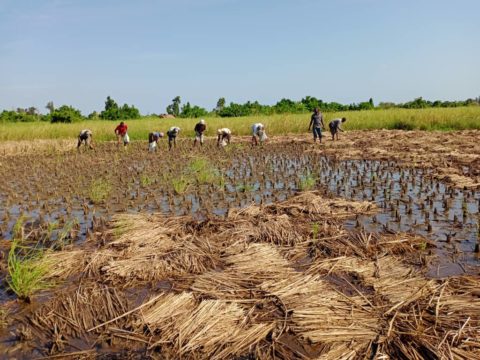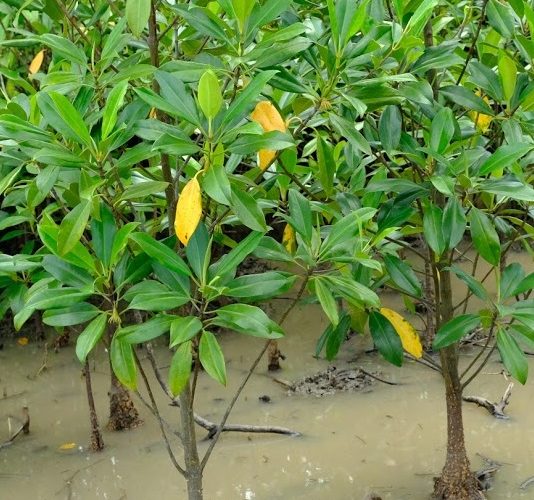As we celebrate World Mangroves Day today, we take stock of the small but sure and steady steps we have made since 2018 towards restoring Rufiji’s blue forests.
Some 200 kilometers south of Dar es Salaam, Tanzania’s capital city, lies the Rufiji Delta. It is home to thousands of coastal rural folk whose lives are closely intertwined with mangroves that span over 53,355 hectares, the largest forest of its kind in Eastern Africa region. The area is also a haven for biodiversity – birdlife, marine and plant species. It is here that Wetlands International, with a 10-year funding support by DOB Ecology, is restoring mangroves using an inclusive and effective community-led approach – that is, restoring mangroves with the community, for the community.
Rice farming, cattle grazing driving loss of Rufiji’s mangroves
Over the years, Rufiji has been affected by both human and natural factors leading to depletion of mangroves that are key to the lives of some 49,000 community members. Threats such as overharvesting of the trees which are hardy for wood fuel and building materials, salt production and human settlement have reduced mangroves.
But Rufiji also faces a challenge unique from other deltas such as Saloum in West Africa as mangrove areas are converted for rice farming and cattle grazing. Studies (Wetlands International, 2018) on the status of ecological resources in the Rufiji Delta estimate that about 7,004 hectares of mangroves have been lost as a result of rice farming between 1991 and 2015. This translates to a loss of about 292 hectares every year. After several years, rice paddies are abandoned. Sadly, the mangroves do not return. Herders also drive their livestock into the Delta, eating and trampling crops and destroy mangroves which leads to habitat degradation.

Mangroves and other trees were slash-burned to make space for rice paddies Pix: D. Wodehouse
In addition, an invasive plant species – a prolific climber that stealthily covers, chokes and kills mangroves – was brought down into the Delta by a shift in water flows.
Restoring conditions for mangroves to grow back
Together with community organizations such as the Village Natural Resource Committees, Beach Management Units, local and national government authorities such as the Tanzania Forest Service and NGOs, Wetlands International has adapted a novel approach to restore Rufiji’s blue forests. Since 2018, we continue to facilitate restoration, monitoring, outreach and learning and ownership of the interventions.
In this review under period, about 200 people, drawn out from the community, government officials, civil society organisations and others, have been directly trained on mangrove ecosystems and their restoration.

Pix: D. Wodehouse
In addition, rather than planting, our restoration approach allows for natural regeneration . Some 20 hectares of mangrove area has so far been restored. Community members weed out the invasive climbers and where propagules are not abundant, they do enrichment planting. Channels are also dug to increase water flow. An estimated 100 community members have boosted their income from this engagement which also cements ownership of the project.

Enrichment planting by community at Mawanda restoration site
To address cattle grazing in the mangrove areas, we, together with other stakeholders, have held meetings with the pastoralists and the Rufiji community to raise awareness and enlist their support in the initiative.
Reviewing the Rufiji Delta Management Plan to include mangroves
Furthermore, to ensure these interventions are backed by strong policy and legal frameworks, we have facilitated the review of the Rufiji Delta Management Plan by various key stakeholders including the community. The current plan was developed 30 years ago (1991) and does not adequately address issues on co-management of the mangroves, invasive species, climate change and other challenges. Once finalized, the plan will act as a tool and guide for the management of the ecosystem for the benefit of both people and nature.
Omari Muomboka, a 53-year old community member, says “Before trade in mangrove forest products such as poles and timber was banned in 2016, it used to contribute about 90% of our income. This plan will support in the sustainable management of the ecosystem and its services in addition to guiding and aiding the resumption of trade in mangrove products to uplift our livelihoods. ”
With these sure steps, it is our hope and dream that Rufiji mangroves and biodiversity will in the foreseeable future grow healthy and offer immeasurable ecosystem services to the local community and beyond while protecting them against the ravages of climate change.


Leave a comment